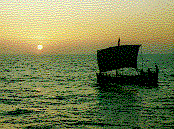
OTHER PROBLEMS
Apart from the problems we had to solve in building the ship, we also had to tackle others related to the ship's daily life. The first one was how to hoist the Greek flag on the boat, to get it registered. It looked quite simple but it proved to be otherwise because according to our legislation ships that cross the seas are classified into certain categories. To mention just a few, there are cargo ships, tankers, "sculleries'; small supporting ships, private recreation ships and cruise ships. Of course 'Kyrenia II'; the replica of 'Kyrenia/'; could not fit into any of these categories. A number of proposals were put forward and, in the end, with the wholehearted support of the Greek authorities, which had been evident throughout the implementation of the programme, the ship was classified as an "experimental ship of primitive construction" ("primitive" meaning rather, "old").
However, our troubles did not come to an end just by naming the ship and registering it because no vessel may sail unless certain prerequisites about safe sailing are met. These include certain rescue equipment, torches and means of communication for the safety of the crew, which are required by Greek as well as international law. Of course we could not secure all the above during the experiment; perhaps there was only some means of emptying any water that got into the hull but archaeologists had not determined this yet. Again, the Greek Authorities gave us their support and stressed that "Kyrenia II" could be built and sail in the same way as we thought the ancient ship did; escort ships could take care of the rest.
Another problem we had to face during registration was that of the ship's ownership. It looked paradoxical at first that we, as a cultural centre, could own a ship which had commercial value. Of course this was also overcome, since the Authorities accepted the experimental and cultural aims of the programme. Thus, the ship became the property of the Hellenic Institute for the Preservation of Nautical Tradition.
Yet another problem we had to deal with, besides registration and launching, was getting the ship insured. Under current law no vessel may sail if it is not covered by insurance during construction and while at sea. We had no problem in having the ship insured while it was being built in the shipyard because there was some value there, the value of making the ship. But we did encounter difficulties in getting the ship insured for voyages because the ship had no commercial value and nothing without commercial value can be insured. We explained that though the ship did not have any commercial value, it was of great archaeological, cultural and national value. Indeed, a Greek insurance company was found, which insured the ship according to the cost of construction and not on the basis of its possible commercial value, which it did not possess."
Extract from a lecture given by the treasurer of HIPNT Mr. STELIOS KOKKINOS at Famagusta Gate in September 1985
Go back to the previous page
Monday, May 27, 1996 11:59:56 PM

